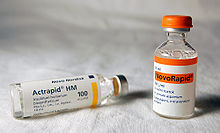User:Mr. Ibrahem/Insulin (medication)
 Vials of insulin | |
| Clinical data | |
|---|---|
| Trade names | Humulin, Novolin, Insuman, others |
| AHFS/Drugs.com | Monograph |
| MedlinePlus | a682611 |
| License data | |
| Routes of administration | Subcutaneous, intravenous, intramuscular, inhaled |
| Drug class | Insulin |
| Legal status | |
| Legal status | |
| Chemical and physical data | |
| Molar mass | 5793.5999 g/mol |
| Density | 1.09[1] g/cm3 |
| Melting point | 233 °C (451 °F) [2] |
Insulin is a protein hormone that is used as a medication to treat high blood glucose.[3] This includes in diabetes mellitus type 1, diabetes mellitus type 2, gestational diabetes, and complications of diabetes such as diabetic ketoacidosis and hyperosmolar hyperglycemic states.[3] It is also used along with glucose to treat high blood potassium levels.[5] Typically it is given by injection under the skin, but some forms may also be used by injection into a vein or muscle.[3]
The common side effect is low blood sugar.[3] Other side effects may include pain or skin changes at the sites of injection, low blood potassium, and allergic reactions.[3] Use during pregnancy is relatively safe for the baby.[3] Insulin can be made from the pancreas of pigs or cows.[6] Human versions can be made either by modifying pig versions or recombinant technology.[6] It comes in three main types short–acting (such as regular insulin), intermediate–acting (such as neutral protamine Hagedorn (NPH) insulin), and longer-acting (such as insulin glargine).[6]
Insulin was first used as a medication in Canada by Charles Best and Frederick Banting in 1922.[7][8] It is on the World Health Organization's List of Essential Medicines.[9] The wholesale cost in the developing world is about US$2 to $11 per 1,000 iu (34.7 mg) of regular insulin and $2 to $11 per 1,000 iu of NPH insulin.[10][11] In the United Kingdom 1,000 iu of regular or NPH insulin costs the NHS £7.50, while this amount of insulin glargine costs £31.[6] In the United States the price was decreased to about US$35 per month as of 2024.[12] In 2017, human insulin was the 73rd most commonly prescribed medication in the United States, with more than ten million prescriptions.[13][14]
References[edit]
- ^ Harding MM, Hodgkin DC, Kennedy AF, O'Conor A, Weitzmann PD (March 1966). "The crystal structure of insulin. II. An investigation of rhombohedral zinc insulin crystals and a report of other crystalline forms". Journal of Molecular Biology. 16 (1): 212–26. doi:10.1016/S0022-2836(66)80274-7. PMID 5917731.
- ^ Abel JJ (February 1926). "Crystalline Insulin". Proceedings of the National Academy of Sciences of the United States of America. 12 (2): 132–6. Bibcode:1926PNAS...12..132A. doi:10.1073/pnas.12.2.132. PMC 1084434. PMID 16587069.
- ^ a b c d e f g h American Society of Health-System Pharmacists. "Insulin Human". www.drugs.com. Archived from the original on 22 October 2016. Retrieved 1 January 2017.
- ^ "WHOCC - ATC/DDD Index". www.whocc.no. Archived from the original on 29 October 2020. Retrieved 2 September 2020.
- ^ Mahoney BA, Smith WA, Lo DS, Tsoi K, Tonelli M, Clase CM (April 2005). "Emergency interventions for hyperkalaemia". The Cochrane Database of Systematic Reviews (2): CD003235. doi:10.1002/14651858.CD003235.pub2. PMC 6457842. PMID 15846652.
- ^ a b c d British national formulary: BNF 69 (69 ed.). British Medical Association. 2015. pp. 464–472. ISBN 9780857111562.
- ^ "Frederick Banting, Charles Best, James Collip, and John Macleod". Science History Institute. June 2016. Archived from the original on 1 December 2018. Retrieved 22 August 2018.
- ^ Fleishman, Joel L.; Kohler, J. Scott; Schindler, Steven (2009). Casebook for The Foundation a Great American Secret. New York: PublicAffairs. p. 22. ISBN 978-0-7867-3425-2. Archived from the original on 2017-01-18.
- ^ World Health Organization (2019). World Health Organization model list of essential medicines: 21st list 2019. Geneva: World Health Organization. hdl:10665/325771. WHO/MVP/EMP/IAU/2019.06. License: CC BY-NC-SA 3.0 IGO.
- ^ "Insulin, Neutral Soluble". International Drug Price Indicator Guide. Archived from the original on 7 July 2018. Retrieved 8 December 2016.
- ^ "Insulin, isophane". International Drug Price Indicator Guide. Archived from the original on 7 July 2018. Retrieved 8 December 2016.
- ^ "Insulin $35 cap price now in effect, lowering costs for many Americans with diabetes". USA TODAY. Archived from the original on 14 January 2024. Retrieved 19 January 2024.
- ^ "The Top 300 of 2020". ClinCalc. Archived from the original on 12 February 2021. Retrieved 11 April 2020.
- ^ "Insulin Human - Drug Usage Statistics". ClinCalc. 23 December 2019. Archived from the original on 28 August 2021. Retrieved 11 April 2020.
